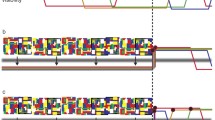Abstract
This study examined the effect of motion on avoidance of interocular suppression in the half-occluded zones, which are non-fusible images projected onto the corresponding retinal areas in natural viewing situations. Six and seven adults participating in Experiments 1 and 2, respectively, measured the amount of suppression in the half-occluded zones. In the moving condition, motion of the occluded surface caused motion of the half-occluded zones in Experiment 1; motion of the occluder caused it in Experiment 2. In the static condition, the occluded surface, half-occluded zones, and occluder were static in Experiments 1 and 2. The results obtained from both experiments indicated that the half-occluded zones were less suppressed in the moving condition than in the static condition. These findings demonstrated that motion of the half-occluded zones contributes to the avoidance of interocular suppression in natural viewing situations.





Similar content being viewed by others
References
B.L. Anderson, K. Nakayama, Psychol. Rev. 101, 414 (1994)
R. Blake, Psychol. Rev. 96, 145 (1989)
R. Blake, K. Boothroyd, Percept. Psychophys. 37, 114 (1985)
R. Hayashi, T. Maeda, S. Shimojo, S. Tachi, Vision. Res. 44, 2367 (2004)
G. Sperling, Am. J. Psychol. 83, 461 (1970)
R. Blake, Y.D. Yang, H.R. Wilson, Vision. Res. 31, 1191 (1991)
J.P. Frisby, J.E. Mayhew, Perception 7, 661 (1978)
B. Julesz, J.E. Miller, Perception 4, 125 (1975)
M.M. Levy, R.B. Lawson, Vision. Res. 18, 239 (1978)
J.E. Mayhew, J.P. Frisby, Nature 264, 53 (1976)
I.P. Howard, Perception 24, 67 (1995)
K. Matsumiya, Opt. Rev. 13, 39 (2006)
K. Matsumiya, I.P. Howard, H. Kaneko, Perception 36, 990 (2007)
J.J. Tsai, J.D. Victor, Vision. Res. 40, 33 (2000)
M. Emoto, T. Mitsuhashi, J. Opt. Soc. Am. A 15, 2257 (1998)
S. Shimojo, K. Nakayama, Vision. Res. 30, 69 (1990)
M. Suzuki, Shinrigaku Kenkyu 71, 486 (2001). [in Japanese]
M. Suzuki, Shinrigaku Kenkyu 73, 270 (2002). [in Japanese]
M. Suzuki, Opt. Rev. 21, 298 (2014)
M. Fahle, Vision. Res. 22, 787 (1982)
W.J.M. Levelt, Brit. J. Psychol. 57, 225 (1966)
N.J. Wade, C.M.M. de Weert, Perception 15, 435 (1986)
N.J. Wade, C.M.M. de Weert, M.T. Swanston, Percept. Psychophys. 35, 111 (1984)
D. I. P. V. Troxler, Ophthalmol. Bibl. 2 (1804) No. 2, 1–53 [in German]
S. Shimojo, K. Nakayama, Vision. Res. 34, 1875 (1994)
K. Bingushi, S. Yukumatsu, Jpn. Psychol. Res. 47, 223 (2005)
H. Ono, R. Angus, P. Gregor, Percept. Psychophys. 21, 513 (1977)
J.M. Wolfe, Psychol. Rev. 93, 269 (1986)
R.A. Abrams, S.E. Christ, Psychol. Sci. 14, 427 (2003)
N.H. Mackworth, Psychon. Sci. 3, 67 (1965)
H. Ono, Shinrigaku Hyouron 17, 156 (1974). [in Japanese]
F.H. Verhoeff, Arch. Ophthalmol. 13, 151 (1935)
Acknowledgments
This study was conducted when the author was at Chukyo University, and was a revision of a part of the author’s unpublished PhD dissertation. The author is deeply grateful to Prof. Takayuki Mori and Dr. Kazuo Bingushi for their helpful advice, and to Ms. Yoshiko Fukami for her cooperation in collecting data.
Author information
Authors and Affiliations
Corresponding author
Rights and permissions
About this article
Cite this article
Suzuki, M. Motion of half-occluded zones contributes to avoidance of interocular suppression in natural viewing situations. Opt Rev 22, 71–78 (2015). https://doi.org/10.1007/s10043-015-0050-4
Received:
Accepted:
Published:
Issue Date:
DOI: https://doi.org/10.1007/s10043-015-0050-4




